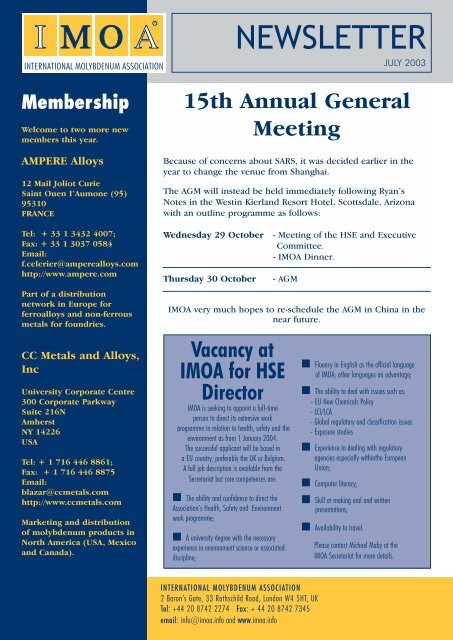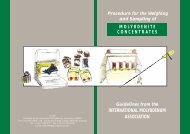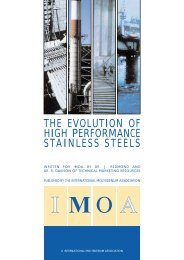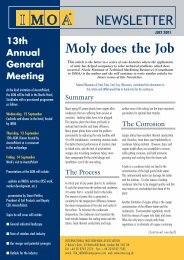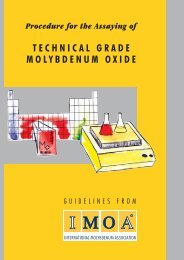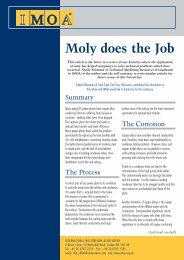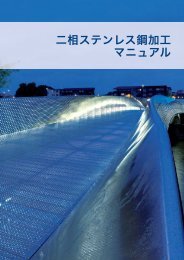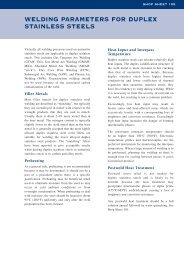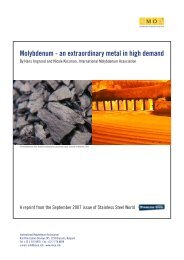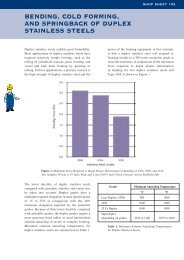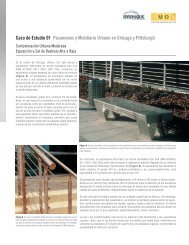2003 - IMOA
2003 - IMOA
2003 - IMOA
You also want an ePaper? Increase the reach of your titles
YUMPU automatically turns print PDFs into web optimized ePapers that Google loves.
R<br />
NEWSLETTER<br />
JULY <strong>2003</strong><br />
Membership<br />
Welcome to two more new<br />
members this year.<br />
AMPERE Alloys<br />
12 Mail Joliot Curie<br />
Saint Ouen I’Aumone (95)<br />
95310<br />
FRANCE<br />
15th Annual General<br />
Meeting<br />
Because of concerns about SARS, it was decided earlier in the<br />
year to change the venue from Shanghai.<br />
The AGM will instead be held immediately following Ryan’s<br />
Notes in the Westin Kierland Resort Hotel, Scottsdale, Arizona<br />
with an outline programme as follows:<br />
Tel: + 33 1 3432 4007;<br />
Fax: + 33 1 3037 0584<br />
Email:<br />
f.celerier@amperealloys.com<br />
http://www.ampere.com<br />
Wednesday 29 October<br />
Thursday 30 October<br />
- Meeting of the HSE and Executive<br />
Committee.<br />
- <strong>IMOA</strong> Dinner.<br />
- AGM<br />
Part of a distribution<br />
network in Europe for<br />
ferroalloys and non-ferrous<br />
metals for foundries.<br />
<strong>IMOA</strong> very much hopes to re-schedule the AGM in China in the<br />
near future.<br />
CC Metals and Alloys,<br />
Inc<br />
University Corporate Centre<br />
300 Corporate Parkway<br />
Suite 216N<br />
Amherst<br />
NY 14226<br />
USA<br />
Tel: + 1 716 446 8861;<br />
Fax: + 1 716 446 8875<br />
Email:<br />
blazar@ccmetals.com<br />
http://www.ccmetals.com<br />
Marketing and distribution<br />
of molybdenum products in<br />
North America (USA, Mexico<br />
and Canada).<br />
Vacancy at<br />
<strong>IMOA</strong> for HSE<br />
Director<br />
<strong>IMOA</strong> is seeking to appoint a full-time<br />
person to direct its extensive work<br />
programme in relation to health, safety and the<br />
environment as from 1 January 2004.<br />
The successful applicant will be based in<br />
a EU country, preferably the UK or Belgium.<br />
A full job description is available from the<br />
Secretariat but core competences are:<br />
■ The ability and confidence to direct the<br />
Association’s Health, Safety and Environment<br />
work programme;<br />
■ A university degree with the necessary<br />
experience in environment science or associated<br />
discipline;<br />
■ Fluency in English as the official language<br />
of <strong>IMOA</strong>; other languages an advantage;<br />
■ The ability to deal with issues such as:<br />
- EU New Chemicals Policy<br />
- LCI/LCA<br />
- Global regulatory and classification issues<br />
- Exposure studies<br />
■ Experience in dealing with regulatory<br />
agencies especially withinthe European<br />
Union;<br />
■ Computer literacy;<br />
■ Skill at making oral and written<br />
presentations;<br />
■ Availability to travel.<br />
Please contact Michael Maby at the<br />
<strong>IMOA</strong> Secretariat for more details.<br />
INTERNATIONAL MOLYBDENUM ASSOCIATION<br />
2 Baron’s Gate, 33 Rothschild Road, London W4 5HT, UK<br />
Tel: +44 20 8742 2274 Fax: + 44 20 8742 7345<br />
email: info@imoa.info and www.imoa.info
Molybdenum Containing Stainless<br />
Steel Spire Graces Dublin<br />
Thanks to Catherine Houska of Technical Marketing Resources (<strong>IMOA</strong> Consultants) for the following article about the Dublin Spire.<br />
A graceful, slender 120-meter (394 ft)<br />
high silver spire now rises from the center<br />
of Dublin. It towers over neighboring<br />
buildings and has changed the city’s<br />
skyline. The new stainless steel landmark<br />
was completed in late January <strong>2003</strong> and<br />
has garnered international attention. Ian<br />
Ritchie Architects, London created the<br />
design and teamed with Arup’s structural<br />
engineers to make it a reality.<br />
The spire is officially called the O’Connell<br />
Street Monument. It is three meters (10 ft)<br />
in diameter at the base and tapers to only<br />
152 millimeters (6 in) in diameter at the<br />
top. The spire is hollow with wall thickness<br />
ranging from 35-mm (1.4 in) at the base<br />
to 10-mm (0.4 in) at the top.<br />
Construction required an international<br />
effort. The plate was polished in France,<br />
rolled into cylinders in Scotland, and<br />
trimmed and welded in Ireland. German<br />
flanges hold the three sections together,<br />
and the damper used to minimize<br />
swaying is from Canada.<br />
Figure 1: The top third of the<br />
spire is being lifted in place.<br />
Ian Ritchie Architects took full advantage<br />
of stainless steel’s aesthetic appeal. The<br />
highly polished finish sparkles day and<br />
night. At night, light shines through<br />
11,884, 15-mm (0.6 in) perforations to<br />
illuminate the top 12 meters (39 feet) of<br />
the monument.<br />
<strong>IMOA</strong> member Arcelor Group’s<br />
Industeel Creusot plate mill in France<br />
produced the cut, bevelled and polished<br />
316L (2.1% Mo) plate.<br />
The project used 126 tonnes of stainless<br />
steel or about 2.5 tonnes of molybdenum.<br />
Type 316L was selected for its superior<br />
corrosion resistance in this coastal city.<br />
The smooth finish will enhance corrosion<br />
resistance and minimize dirt accumulation<br />
over time.<br />
2<br />
Figure 2: The Dublin spire rises 120 meters (394 feet) high over the city.
manufacturers will be required to submit<br />
information specific to their company and<br />
product (i.e. identity of the manufacturer or<br />
importer, the substance, information on the<br />
manufacture and use of the substance and a<br />
statement as to whether or not information<br />
has been generated by testing a vertebrate<br />
animal). A further advantage of consortia is<br />
that each company that participates will only<br />
be required to pay one third of the<br />
registration fee.<br />
New Members<br />
/Licensees<br />
Following pre-registration, the Agency will<br />
inform a manufacturer or importer of<br />
the identity of any previous registrants or<br />
provide details of any on-going testing in<br />
relation to identical substances. The<br />
manufacturer or importer will then need to<br />
contact the relevant company/consortium in<br />
order to obtain access to the required<br />
technical information. The individual<br />
registrant or consortium will be required to<br />
provide the new registrant, subject to the<br />
agreement of an appropriate fee, with any<br />
data submitted to the Agency as part of the<br />
technical dossier or with any on-going<br />
research and test results. Each consortium<br />
will be set up to provide the information to<br />
the new registrant by either<br />
(1) admitting the new registrant as a new<br />
member of the consortium; or (2) licensing<br />
the required information to the new<br />
registrant, both for an agreed fee.<br />
years from registration. Consequently, any<br />
new registrant will need to join or obtain a<br />
licence from the consortium in order to gain<br />
access to the technical dossier. Each<br />
consortium will be free to license the<br />
technical information on whatever terms it<br />
deems appropriate. However, if the parties<br />
cannot agree an appropriate fee, the Agency<br />
will impose a maximum royalty of 50% of the<br />
original cost of producing the information.<br />
Once this 10 year period has expired, the<br />
Agency will be able to provide the new<br />
registrant with the contents of the<br />
technical dossier directly.<br />
Time limits<br />
In order to phase-in the application of the<br />
new EU chemicals policy, the Commission<br />
has provided a transitional period of 11 years<br />
within which to complete all registrations.<br />
The exact registration deadline will depend on<br />
the volume of the chemical substance<br />
manufactured or imported:<br />
Competition Law<br />
Compliance<br />
The formation of industry consortia, the<br />
exchange of data among competitors,<br />
decision(s) to exclude companies from the<br />
consortia and joint licensing all raise potential<br />
competition issues under Articles 81 and 82<br />
of the EC Treaty. As such, consortia and their<br />
members will need guidance on competition<br />
rules applicable to the operation of the<br />
consortia.<br />
Sanctions<br />
Member States will set the appropriate<br />
penalties for infringements. It is expected that<br />
the Member States will impose fines for<br />
non-compliance of up to a maximum of 10%<br />
of the annual world-wide turnover of the<br />
undertaking concerned.<br />
● in excess of 1,000 tonnes or CMRs over 1 tonne - within 3 years<br />
● 100 - 1,000 tonnes - within 6 years<br />
● 1 - 100 tonnes - within 11 years.<br />
Data Rights<br />
Each consortium will own the exclusive rights<br />
to the technical dossier for each substance<br />
registered with the Agency for a period of 10<br />
Readers with interests in products other than molybdenum are<br />
welcome to contact <strong>IMOA</strong>’s Counsel direct:<br />
Scott S. Megregian, McDermott, Will & Emery, 7 Bishopsgate, London EC2N 3AQ<br />
Tel: 44-(0)20-7577-6911 email: smegregian@mwe.com<br />
7
The New System<br />
There are five key elements to REACH:<br />
● Duty of Care<br />
- all companies that manufacture, import<br />
and use chemicals (regardless of the<br />
quantity) must ensure that their use of<br />
chemical substances does not adversely affect<br />
human health or the environment.<br />
● Registration -<br />
any manufacturer of a substance in the EU<br />
or importer of a substance into the EU, in<br />
volumes of 1 tonne or more must register it<br />
with the new European Chemicals Agency (to<br />
be based in Ispra, Italy). Member State<br />
authorities are responsible for reviewing the<br />
registration and on-going enforcement.<br />
● Evaluation -<br />
every registrant must submit a technical<br />
dossier on each substance which includes<br />
details of the substance’s intrinsic properties<br />
and relevant test results. If the registrant does<br />
not have the required test data and no<br />
previous test results are available, additional<br />
testing will need to be carried out.<br />
The registrant must submit a test proposal<br />
and receive prior authorisation from the<br />
competent Member State authority.<br />
The relevant Member State authority will<br />
review the technical dossier submitted and<br />
any test proposals as part of a ‘Standard<br />
Evaluation’. The Member State authority can<br />
also conduct a further ‘Priority Evaluation’ to<br />
verify the quality of the information<br />
submitted and to obtain additional<br />
information about the risks posed by the<br />
substances.<br />
● Authorisation<br />
- the Commission or competent Member<br />
State authority must also authorise the use<br />
of carcinogenic, mutagenic or toxic to<br />
reproduction chemical substances (CMRs)<br />
and other substances which raise concern.<br />
The relevant authority will approve the<br />
product where the risks to human health<br />
and/or the environment are adequately<br />
controlled.<br />
● Restrictions<br />
- certain chemical substances must comply<br />
with any restrictions before they can be<br />
manufactured, placed on the market or used.<br />
The Commission will have sole authority to<br />
amend or impose restrictions following advice<br />
from the Agency.<br />
Required Information<br />
The volume of each chemical substance<br />
manufactured or imported into the EU will<br />
determine the level of information required.<br />
Any manufacturer or importer of a chemical<br />
substance in quantities of more than 1 tonne<br />
must submit a technical dossier to the<br />
Agency. The technical dossier must contain<br />
details of the registrant, the chemical<br />
substance, the manufacture and use of the<br />
substance, its classification and labelling,<br />
guidance on the safe use of the substance,<br />
summaries of the standard testing<br />
information, a statement as to whether<br />
vertebrate animal testing has been conducted,<br />
any proposals for further tests and a chemical<br />
safety report. Specific physicochemical and<br />
toxicological information must also be<br />
submitted. Additional physicochemical and<br />
toxicological data are required if the<br />
manufacturer or importer sells more than 10<br />
tonnes of a particular substance in the EU,<br />
with the data requirements increasing for<br />
quantities exceeding 100 tonnes or 1,000<br />
tonnes. This increasing burden reflects the<br />
greater safety risk associated with larger<br />
volumes of chemical substances.<br />
Pre-registration<br />
All manufacturers or importers must preregister<br />
all substances at least 18 months<br />
before the appropriate registration deadline<br />
expires. Once this pre-registration is made,<br />
all registrants will become a member of the<br />
Substance Information Exchange Forum.<br />
SIEF is designed to encourage the sharing of<br />
information and assess the need to conduct<br />
further studies. However, the SIEF will not<br />
replace the need for industry consortia.<br />
Manufacturers or importers will also have to<br />
notify the Agency, for labelling and<br />
classification purposes, of any registrable<br />
substances and other dangerous substances<br />
within 18 months of the entry into force of<br />
the Regulation. The Commission will provide<br />
a standard form for this purpose.<br />
Creation of Consortia<br />
The registration requirements place a<br />
considerable burden on manufacturers and<br />
importers. In order to reduce this burden<br />
and avoid unnecessary additional animal<br />
testing, the Commission recommends the<br />
creation of consortia by manufacturers and<br />
importers in order to prepare the detailed<br />
technical dossier on each chemical<br />
substance.<br />
Each consortium will focus on developing the<br />
information required for each substance<br />
common to its respective members. This<br />
"common" information will constitute the<br />
vast bulk of data which must be submitted.<br />
In addition, however, individual importers or<br />
6
Moly Does the Job<br />
This case study has been kindly contributed by Dr Peter Dierschke, Materials<br />
Consultant to the Hempel Special Metals Group,Oberhausen, Germany<br />
(the company may be contacted on info@hempel-metals.com)<br />
Molybdenum Brings Safety into Swimming Pool Buildings<br />
Summary<br />
In 1985 the suspended ceiling of a swimming pool<br />
in Uster, Switzerland crashed down into the pool<br />
and killed 12 bathers. Several years later, in 2001,<br />
a similar accident occurred in The Netherlands –<br />
fortunately in the second case during the night<br />
without casualties. The accidents were found to be<br />
caused by stress corrosion cracking of molybdenumfree<br />
Type 304 stainless steel fasteners and hangers<br />
that carried the weight of the suspended ceiling.<br />
While the standard grade stainless steels like Type<br />
304 and the 2% molybdenum containing Type 316<br />
perform well in many applications in and around<br />
swimming pools, they should not be used for<br />
safety-critical, load-bearing applications. Only<br />
highly corrosion resistant 6% molybdenum-type<br />
stainless steel can resist stress corrosion cracking in<br />
the aggressive environment that can build in spaces<br />
where maintenance cleaning is difficult or<br />
impossible.<br />
The Application<br />
Stainless steels are well established as corrosion<br />
resistant, low maintenance, construction materials<br />
in and around swimming pools. They are found in<br />
the pool water as ladders, stairs, and components of<br />
wave machines, around the pool, for example as<br />
diving boards, and as parts of the building like air<br />
conditioning systems, doors and windows. The<br />
widespread use is due to the good corrosion<br />
resistance, the attractive appearance, the good<br />
workability and an acceptable price. The formation<br />
of a thin but extremely dense oxide layer on the<br />
surface of stainless steels, the passive layer, protects<br />
the steel from corrosion.<br />
Because of their corrosion resistance stainless steels<br />
are also used in structural applications in swimming<br />
pool buildings such as for hangers and fasteners of<br />
components such as suspended ceilings, wall panels<br />
or water piping and air ducts.<br />
The Corrosion<br />
To kill bacteria and viruses introduced by bathers,<br />
disinfecting agents, often chlorine based chemicals,<br />
are introduced to the pool water. The pool water<br />
chemistry is extremely complex: Chlorine reacts with<br />
nitrogenous compounds found in sweat and urine to<br />
form chloramines. The chloramines are highly<br />
volatile and are responsible for the characteristic<br />
"pool smell". Chloramines are, due to their high<br />
volatility, spread in the whole atmosphere of the<br />
pool. They are found to be absorbed into<br />
condensates formed on the surfaces even in the<br />
most remote part of the pool building. Because<br />
these areas are not regularly washed, they can form<br />
an extremely corrosive<br />
electrolyte containing high<br />
amounts of chlorides with low<br />
pH – value over time.<br />
This aggressive electrolyte<br />
turned out to be capable of<br />
causing room temperature<br />
chloride stress corrosion<br />
cracking (CSCC) in Type 304<br />
stainless steel (Figure 1). This<br />
was a surprising finding,<br />
because up to the time of the<br />
first accident, it was believed<br />
that CSCC of this stainless steel<br />
does not occur below<br />
50 to 60 °C (120 – 140 °F).<br />
The Solution<br />
Moly does the job<br />
In the following years many corrosion investigation<br />
programs were carried out on this topic. In several<br />
working programs it was found that the<br />
molybdenum – free type 304 and low molybdenum<br />
type 316 can suffer CSCC under severe pool<br />
conditions. Even the Duplex stainless steel 2205<br />
suffered localized corrosion in these conditions<br />
which can lead to significant reduction of the<br />
strength. Only the 6% - Mo stainless steels showed<br />
sufficient corrosion resistance.<br />
The results of the test programs have found their<br />
way into national building regulations like the<br />
German bauaufsichtliche Zulassung Z-30.3-6 from<br />
1999 "Bauteile und Verbindungselemente aus<br />
nichtrostenden Stählen". Figure 2 shows part of<br />
this regulation wherein four categories of corrosivity,<br />
from low to high, are defined. Category 4 "high" is<br />
used for constructions with high load of chlorides<br />
and other pollutants if concentration of<br />
pollutants can occur because the area cannot<br />
be accessed for cleaning. Under these<br />
conditions the stainless steels 1.4565, 1.4529<br />
and 1.4547 are specified.<br />
As a reaction to these findings, two swimming<br />
pools in The Netherlands recently changed their<br />
under-roof suspensions from galvanised steel to a<br />
6% Molybdenum stainless steel. Figure 3 shows<br />
a fastener made completely out of alloy 926 for<br />
suspension of a ceiling construction.<br />
Figure 1: Part of a suspension made of Type 304 damaged by<br />
Stress corrosion cracking in the atmosphere of a swimming pool.<br />
Acknowledgement<br />
Figure (1) Courtesy of Mr Jan Heselmans, Force Technology b.v., published in"Stainless Steel World" (December 2001).<br />
3
Moly does the job<br />
Figure 2: German building code: bauaufsichtliche Zulassung Z-30.3-6, 1999.<br />
The Cost Savings<br />
Most importantly, by using 6% Molybdenum<br />
stainless steel the safety of the swimming pool is<br />
increased. Additionally, the maintenance and<br />
repair cost and time for the pool are reduced and<br />
the time between necessary inspections is longer.<br />
This leads to shorter shut-down times and to direct<br />
cost saving because of increased revenue.<br />
Table 1:<br />
Chemical composition and EN and UNS<br />
numbers of the different stainless steels.<br />
Figure 3: Hanger made of Alloy 926 for the suspension of a ceiling.<br />
Some stainless steels used in swimming pools<br />
Alloy UNS No. Werkstoff Nr. Nominal composition %<br />
Cr Ni Mo Other<br />
304 S30400 1.4301 19 9,5 - -<br />
316 S31600 1.4401 17 12 2,5 -<br />
2205 S32205 1.4462 22 5 3 -<br />
926 N08926 1.4529 20 25 6,5 Cu, N<br />
254SMO S31254 1.4547 20 18 6.1 N<br />
S34565 1.4565 24 18 4.5 Mn,N<br />
4
Stainless<br />
Steel in<br />
Automobiles<br />
The International Stainless Steel<br />
Forum (ISSF) and <strong>IMOA</strong> are jointly<br />
organizing a session on "stainless<br />
steel" at the 2004 Society of<br />
Automotive Engineers (SAE) World<br />
Congress to be held March 8-11, 2004<br />
in Detroit. The call for papers within<br />
and outside of ISSF yielded ten<br />
relevant abstracts on stainless steels<br />
for automotive applications. This is<br />
enough to fill a full day program at<br />
the Conference. Most papers come<br />
from stainless steel producer<br />
companies, often jointly written with<br />
industry partners. <strong>IMOA</strong>’s Technical<br />
Director, Dr. Nicole Kinsman is the<br />
official session organizer and<br />
Chairperson.<br />
In the past years there have been<br />
sessions concentrating on aluminum,<br />
steel, magnesium, plastics and other<br />
materials but not one dedicated to<br />
stainless steel. Automotive engineers<br />
are often not familiar with the great<br />
properties (especially the mechanical<br />
properties) of stainless steels and are<br />
therefore not specifying them. The<br />
special session at the next SAE<br />
conference is intended to make<br />
automotive specifiers aware of the<br />
design possibilities with stainless steel.<br />
EU New<br />
Chemicals<br />
Policy – the<br />
Facts<br />
Counsel to the Association<br />
(McDermott, Will & Emery) has<br />
prepared the information below<br />
which provides a concise<br />
introduction to the NCP and<br />
contains proposals for the most<br />
practical and economic method<br />
of organising and preparing for<br />
compliance by the formation of<br />
consortia to save individual<br />
companies time and money.<br />
For any company which<br />
produces molybdenum in, or<br />
exports molybdenum to, the EU,<br />
the obvious consortium to join is<br />
<strong>IMOA</strong> itself.<br />
Introduction<br />
The European Commission has proposed an<br />
expansive new policy requiring chemical and<br />
metallurgical manufacturers and importers to<br />
register each substance manufactured or<br />
imported into the European Union. The key<br />
provisions of the proposed system are set out<br />
in a 1200 page consultation document, known<br />
as "REACH" (standing for registration,<br />
evaluation and authorisation of chemicals),<br />
published on 07 May <strong>2003</strong>. REACH creates a<br />
new system designed to deliver the<br />
information needed to identify the status of<br />
chemical substances in use in the EU<br />
and minimise the potential health and<br />
environmental risks from these various<br />
chemical substances.<br />
The new system will place an obligation on<br />
individual companies to submit a technical<br />
dossier and register any chemical substance<br />
manufactured or imported into the EU in<br />
quantities of more than 1 tonne. In order to<br />
assist companies with the registration process,<br />
the Commission recommends the creation of<br />
industry consortia.<br />
These consortia will enable the joint<br />
development, submission and sharing of<br />
information with the aim of reducing the<br />
compliance burden on individual companies<br />
and preventing unnecessary additional animal<br />
testing.<br />
In order to help companies to organise<br />
themselves and begin the compliance process,<br />
McDermott, Will & Emery have designed a<br />
standard "Chemicals Policy Consortium<br />
Package". The package includes the necessary<br />
legal documents for the initial formation and<br />
operation of such consortia. The materials are<br />
available in a form that can be tailored to meet<br />
the particular needs of industry groups or<br />
individual companies.<br />
Chemical Substances<br />
The new system requires the registration of<br />
chemical substances manufactured or<br />
imported into the EU. The chemical<br />
substances that require registration are<br />
chemical elements and compounds in their<br />
natural state or obtained through a<br />
manufacturing process. Any substances<br />
previously notified under Directive 67/548/EC<br />
(which covers the labelling of dangerous<br />
substances) will automatically be considered as<br />
registered. There are special rules<br />
concerning polymers and intermediates. The<br />
Commission has also provided a list of<br />
substances which do not require registration.<br />
Finally, any substances which are the<br />
subject of other EC Directives do not require<br />
registration(e.g.medicinal products, food<br />
additives and food flavourings).<br />
5
R<br />
LIST of MEMBERS<br />
Secretary-General:Michael Maby<br />
AUSTRIA<br />
Interalloys Trading & Business Consulting GmbH<br />
Floragasse 7, A-1040 Vienna, AUSTRIA<br />
Tel: + 43 1 504 6138; Fax: + 43 1 504 6192<br />
E-mail: interal@ycn.com<br />
Treibacher Industrie AG<br />
A-9330 Althofen, AUSTRIA<br />
Tel: + 43 4262 5050; Fax: + 43 4262 2813<br />
E-mail: tam@treibacher.at http://www.treibacher.at<br />
BELGIUM<br />
Sadaci NV<br />
Langerbruggekaai 13, B-9000 Gent, BELGIUM.<br />
Tel: + 32 92 540 511; Fax: + 32 92 540 571<br />
E-mail: msmeets@sadaci.be http://www.sadaci.be<br />
CANADA<br />
Ni-Met Resources Inc.<br />
6130 Tomken Road, Mississauga, ON L5T 1T6 Canada<br />
Tel: +1 905 564 1042; Fax: + 1 905 564 2564<br />
E-mail: anil@ni-met.com<br />
CHILE<br />
Codelco Chile<br />
Huerfanos 1270, Santiago, CHILE<br />
Tel: + 56 2 690 3406; Fax: + 56 2 690 3366<br />
E-mail: jleibbra@stgo.codelco.cl http://www.codelco.cl<br />
Molibdenos y Metales S.A.<br />
Huærfanos 812, 6th Floor, Santiago, CHILE<br />
Tel: + 56 2 368 3600; Fax: + 56 2 368 3653<br />
E-mail: info@molymet.cl http://www.molymet.cl<br />
CHINA<br />
Chaoyang Jinda Molybdenum Co., Ltd<br />
8 Nanda Street, Chaoyang, Liaoning 122000, P R CHINA<br />
Tel: + 86 421 265 1117 Fax: + 86 421 265 1887<br />
E-mail: cymoly@mail.cyptt.In.cn<br />
Jinduicheng Molybdenum Mining Corporation<br />
17th Floor, Jie Rui Mansion, No. 5 West section of the second south Ring Road,<br />
Xian, Shaanxi Province, P.C. 710068 P.R. CHINA<br />
Tel: +86 29 837 8676; Fax: +86 29 837 8771<br />
E-mail: jck@jdcmmc.com http://www.jdcmmc.com<br />
Jinzhou Sing Horn Enterprise Co., Ltd<br />
No.56, Shangdali, Taihe District, Jinzhou Liaoning 121004, CHINA<br />
Tel: + 86 416 517 1930; Fax: + 86 416 517 1944<br />
E-mail: jzlhshs@mail.jzptt.ln.cn http://www.singhorn.com<br />
FRANCE<br />
Arcelor Purchasing<br />
11/13 Cours Valmy<br />
92070 La Defense Cedex FRANCE<br />
Tel: + 32 89 302 401; Fax: + 32 89 302 005<br />
E-mail: paul.gielen@purchasing.arcelor.com http://www.ugine-alz.com<br />
Ampere Alloys<br />
12 Mail Joliot Curie, Saint Ouen L’Aumone (95)<br />
95310 FRANCE<br />
Tel: + 33 1 34 32 4007; Fax: + 33 1 30 37 0584<br />
E-mail: f.celerier@amperealloys.com<br />
GERMANY<br />
F W Hempel Metallurgical GmbH<br />
Leopoldstr. 16, D-40211 Düsseldorf GERMANY<br />
Tel: + 49 211 168 060; Fax: + 49 211 168 0644<br />
E-mail: f.-w.hempel@fwhempel.com http://www.fwhempel.de<br />
Metherma GmbH<br />
Arnheimer Str. 103<br />
D-40489 Düsseldorf, GERMANY<br />
Tel: + 49 211 40 80 840; Fax: + 49 211 40 71 26<br />
E-mail: metherma.molybdenum@t-online.de<br />
H C Starck GmbH & Co KG<br />
Im Schleeke 78 - 91, Postfach 25 40<br />
D-38615 Goslar, GERMANY<br />
Tel: + 49 5321 7510; Fax: + 49 5321 751 192<br />
E-mail: georg.nietfeld.gn@hcstarck.de http://www.hcstarck.com<br />
ISRAEL<br />
Metal-Tech Ltd<br />
Ramat Hovav, P.O. Box 2412<br />
Beer-Sheva 84874 ISREAL<br />
Tel: + 972 8 657 2333; Fax: + 972 8 657 2334<br />
E-mail: ran@metal-tech.co.il<br />
JAPAN<br />
Kohsei Co., Ltd<br />
Marukashiwa Building, 6F 1-6-1 Honcho Nihonbashi Chuo-ku, 103-0023 Tokyo,<br />
JAPAN<br />
Tel: + 81 3 3270 0303; Fax: + 81 3 3270 7504<br />
E-mail: furuta@kohsei.co.jp<br />
Nissho Iwai Corp<br />
Tradepia Odaiba<br />
3-1, Daiba 2-chome, Minato-ku<br />
Tokyo 135-8655, JAPAN<br />
Tel: + 81 3 5520 3529; Fax: + 81 3 5520 3517<br />
E-mail: matsumura.hiroshi@nisshoiwai.com<br />
Taiyo Koko Co., Ltd<br />
3-1, 3-chome Marunouchi, Chiyoda-ku<br />
Tokyo 100-0005, JAPAN.<br />
Tel: + 81 3 3216 6041; Fax: + 81 3 3216 6045<br />
E-mail: trade@taiyokoko.co.jp<br />
LUXEMBOURG<br />
Considar Europe SA<br />
3 rue Pletzer, Centre Helfent, L-8080 Bertrange LUXEMBOURG.<br />
Tel: + 352 45 99 99 1 Fax: + 352 45 99 99 223<br />
E-mail: heinz.duechting@considar.lu<br />
MEXICO<br />
Mexicana de Cobre SA de CV<br />
Av. Baja California 200, Col. Roma Sur<br />
06760 Mexico DF, MEXICO<br />
Tel: + 52 555 264 7775; Fax: + 52 555 264 7769<br />
E-mail: adenekeng@gmexico.com.mx http://www.gmexico.com<br />
PERU<br />
Southern Peru Copper Corporation<br />
Av. Caminos del Inca 171<br />
Chacarilla del Estanque, Surco, Lima 33, PERU<br />
Tel: + 51 1 372 1414; Fax: + 51 1 372 0237<br />
E-mail: jdlheros@southernperu.com.pe http://www.southernperu.com<br />
SWEDEN<br />
AvestaPolarit Oyj Abp<br />
S-774 80 Avesta, SWEDEN<br />
Tel: + 46 226 810 00; Fax: + 46 226 813 05<br />
E-mail: marie.louise.falkland@avestapolarit.com<br />
Scandinavian Steel AB<br />
Birger Jarlsgatan 15<br />
SE 111 45 Stockholm, SWEDEN<br />
Tel: + 46 8 614 2850; Fax: + 46 8 611 6434<br />
E-mail: metals@scandinaviansteel.se<br />
UK<br />
Adams Metals Ltd<br />
Norwich House, 14 North Street, Guildford, Surrey GU1 4AF, UK<br />
Tel: + 44 1483 577900; Fax: + 44 1483 578008<br />
Toll Free/ USA– Tel: +1 800 473 8427; Fax: +1 800 473 8428<br />
E-mail: adamsmetals@btinternet.com http://www.adamsmetals.com<br />
Eastlink Ferro Alloys Ltd<br />
Surrey Street, Glossop, Derbyshire SK13 7AL UK<br />
Tel: + 44 1457 852333; Fax: + 44 1457 855655<br />
E-mail: david.l@eastlinklanker.com http://www.ferroalloys.demon.co.uk<br />
Alfred H Knight International Ltd<br />
Eccleston Grange, Prescot Road, St Helens, Merseyside WA10 3BQ, UK<br />
Tel: + 44 1744 733757; Fax: + 44 1744 27062<br />
E-mail: st-helens@alfred-h-knight.co.uk<br />
Derek Raphael & Co Ltd<br />
2nd Floor, 6 York Street, London W1U 6PL, UK<br />
Tel: + 44 20 7535 1690; Fax: + 44 20 7535 1691<br />
E-mail: DRaphael@derek-raphael.co.uk<br />
http://www.derek-raphael.co.uk<br />
Alex Stewart (Assayers) Ltd<br />
Caddick Road, Knowsley Industrial Estate Merseyside LL34 9ER, UK.<br />
Tel: + 44 151 548 7777; Fax: + 44 151 548 0714<br />
E-mail: enquiries@ alexstewart.com<br />
Wogen Resources Ltd<br />
4 The Sanctuary, Westminster<br />
London SW1P 3JS, UK.<br />
Tel: + 44 20 7222 2171; Fax: + 44 20 7222 5862<br />
E-mail: akerr@wogen.co.uk http://www.wogen.com<br />
USA<br />
Barex Resources, Inc.<br />
93 The Circle, Passaic Park, NJ 07055 USA<br />
Tel: + 1 973 778 6470; Fax: + 1 413 460 7930<br />
E-mail: nrshapiro@attglobal.net<br />
Bear Metallurgical Company<br />
679 East Butler Road<br />
Butler, PA 16001, USA<br />
Tel: + 1 724 283 6800; Fax: + 1 724 283 6078<br />
E-mail: kjones@bearmet.com<br />
CC Metals and Alloys, Inc<br />
300 Corporate Parkway<br />
Suite 216N, Amherst, NY 14226, USA<br />
Tel: + 1 716 446 8861; Fax: + 1 716 446 8875<br />
E-mail: blazar@ccmetals.com http://www.ccmetals.com<br />
The Chem-Met Co<br />
P O Box 819, Clinton, MD 20735-0819, USA<br />
Tel: + 1 301 868 3355; Fax: + 1 301 868 8946<br />
E-mail: afox@chem-metco.com<br />
Climax Molybdenum Company<br />
One North Central, Phoenix,<br />
AZ 85004, USA<br />
Tel: + 1 602 366 8100; Fax: + 1 602 366 7329<br />
E-mail: dthornton@phelpsdodge.com<br />
http://www.phelpsdodge.com<br />
Comsup Commodities Inc<br />
1 Bridge Plaza North, Fort Lee, NJ 07024, USA<br />
Tel: + 1 201 947 9400; Fax: + 1 201 461 7577<br />
E-mail: comsup@comsupinc.com<br />
Kennecott Molybdenum Company<br />
8315 West 3595 South, P O Box 6001,<br />
Magna Utah 84044-6001, USA<br />
Tel: + 1 801 252 3000; Fax: + 1 801 252 3292<br />
E-mail: sullivas@kennecott.com<br />
Molycorp Inc<br />
376 S. Valencia Avenue, Brea<br />
California 92823, USA<br />
Tel: + 1 714 577 1757 ; Fax: + 1 714 577 2779<br />
E-mail: cjcynor@unocal.com<br />
Osram Sylvania Products Inc<br />
Hawes Street, Towanda, PA 18848, USA.<br />
Tel: + 1 570 268 5000; Fax: + 1 570 268 5113<br />
E-mail: susan.dunn@sylvania.com<br />
Powmet Inc<br />
P O Box 5086, 2625 Sewell Street<br />
Rockford, IL 61125, USA.<br />
Tel: + 1 815 398 6900; Fax: + 1 815 398 6907<br />
E-mail: wct@powmet.com<br />
Shangxiang Minmetals Inc.<br />
150 N. Santa Anita Ave. Suite 500<br />
Arcadia, CA 91006<br />
USA<br />
Tel: + 1 626 445 8946; Fax: + 1 626 445 6943<br />
E-mail: georgesong@e-metalmarket.com<br />
Thompson Creek Metal Company<br />
945 West Kenyon Avenue, Englewood<br />
CO 80110-3469, USA<br />
Tel: + 1 303 761 8801; Fax: + 1 303 761 7420<br />
E-mail: marionc@tcrk.com


